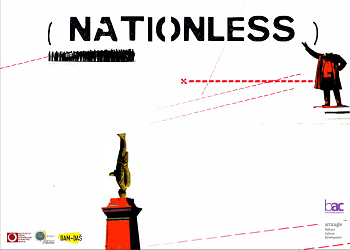
We kindly inform you that, as long as the subject affiliation of our 300.000+ articles is in progress, you might get unsufficient or no results on your third level or second level search. In this case, please broaden your search criteria.

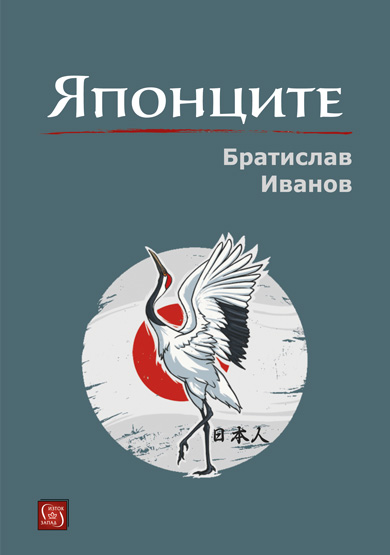
Bratislav Ivanov's new book is dedicated to the values and traditions of the Japanese culture. Already in the early twentieth century, French scientist Henry Dumolard draws attention to the fact that the Japanese people are guided by their logic and draw conclusions that are often incomprehensible to Europeans. To understand the Japanese people, we need to know the values that form the core of their culture. A key to their understanding is the geographical environment, mythology, religion, and Japan's history.
More...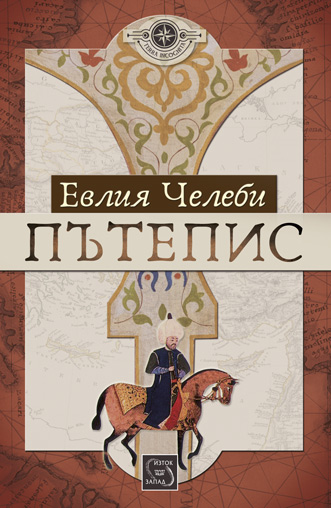
Evliya Celebi was an enlightened man in a variety of ways who believed in equality, freedom of thought and intellectual debate, and found all of these things present in Islamic societies. Over the course of his travels, he wrote ten volumes detailing his adventures. ‘Seyahatname’ – Book of Travels – is a unique and important text, representing one of the few accounts of the 17th century and the Ottoman world from the perspective of a Muslim. These are not just factual accounts, Evliya had a great imagination and just as important as his journal entries were the imaginative storytelling that ran alongside, elaborating, exaggerating, and fantasizing. Through his stories, we are prompted to think more imaginatively about our own travels and journeys to other cities. This 17th-century Muslim traveler can sometimes seem narrow-minded and yet this same man can stand in St Stephens Cathedral in Vienna and be moved by the music he hears. Sometimes these encounters lead to nothing but sometimes they lead to stories which are so deeply felt, and so universally melodic that they leave echoes which can still be heard and felt today. In 2011, the year which would have been his 400th birthday, Evliya is being paid homage as UNESCO’s Man of the Year.
More...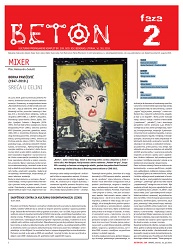
MIXER, Aleksandra Sekulić: Borka Pavićević – Sreća u celini; CEMENT, Saša Ćirić: Nikog nema doma; ŠTRAFTA, Milica Rakić: Legat Konstantina Koče Popovića; ZID, Milica Rakić: Ja nisam oslobodila Beograd
More...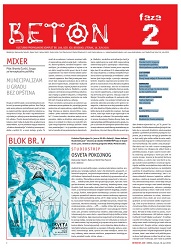
MIXER, Branka Ćurčić, Grupa za konceptualnu politiku: Municipalizam u gradu bez opština; anti CEMENT, Saša Ćirić: I konji konje ubijaju ili Dunavska uteha; ARMATURA, Jelena Veljić: To što oni pričaju i to što mi živimo su dve različite stvari; VREME SMRTI I RAZONODE, Radivoj Šajtinac: Bez ustezanja; ZID, Aurélie William Levaux; BLOK BR. V, Studiostrip: Osveta pokojnog
More...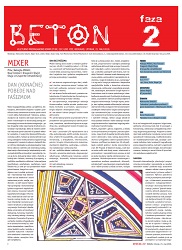
MIXER, Nebojša Milikić, Noa Treister i Dragomir Olujić Oluja iz Grupe Ne-rehabilitaciji: Dan (konačne) pobede nad fašizmom; CEMENT, Saša Ćirić: Lari, Vera, Koča, Kapa i ja; ARMATURA, Jelena Veljić: 67 je previše!; ŠTRAFTA, Aleksandra Sekulić: Podvodne i podvođene prošlosti, i govor budućnosti – Oberhauzen 2019.; ZID, Zoran Naskovski: Mandala i krst / Zbogom oružje
More...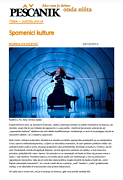
Svojevremeno sam, sa Jovanom Ćirilovim, radila u komisiji Uneska na zaštiti manastira na Kosovu, da skratim, znam šta bi sve trebalo da izgovorim i u ovoj prilici, i koliki je bio proces učenja da od „spomenika kulture“ dođemo do svih oblika kvalifikovanja i izražavanja, e ne bi li se postigao cilj da se manastiri zaštite, i to u stepenu opasnosti.
More...
𝑆𝑜𝑐𝑖𝑒𝑡𝑎𝑠 𝐶𝑙𝑎𝑠𝑠𝑖𝑐𝑎 is a multilingual collection of papers presented at the international scientific conference that has been organized by the Department of Classical and Eastern Languages and Cultures of St. Cyril and St. Methodius University of Veliko Tarnovo (Bulgaria) since 2002. Until 2015, the conference was held annually. Since 2018, it is held once every two years. St Cyril and St Methodius University Press issues the collection within the Dr. Nicola Piccolo series. The wide range of topics and the opportunity for authors to submit their academic publications in the original language attracts researchers from all over the world.
More...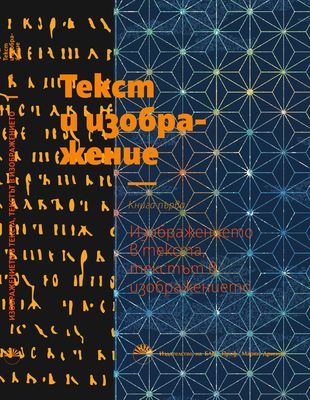
In the early years of cinema, caricatures played an important role in its popularization in Bulgarian lands – a topic that has not been explored enough. The first humorous publications (“Balgaran”, Baraban”, “Smyah”) advertised first cinemas, but also published cartoons, poems, feuilletons, etc., inspired by the world of cinema. The language of film influenced the expression of artists and cartoonists, and films adapted for screen humorous drawings and cartoon series
More...
In its wholeness, the comic does not rely solely on optical illusion to realize its effect on the reader. The consecutively arranged squares on the paper strip reflect certain phases of movement, almost always frozen in the most important, sublime moment. In this way, regardless of the lack of sequence of all the main, even all the key phases, the reader manages to reproduce in his mind the overall illusion of action. And even for the development of this action in time and space. It is supplemented with plans of different sizes, with the accumulation of specific sounds, with the created three-dimensional illusion for a more real perception of the action, etc. Most often it also contains a textual, explanatory version, in which the steps of the individual movements are traced to reach the final and complete action of the character in the frame. As well as lines of characters that reveal additional elements of narrative, emotions, aesthetic evaluations. Sometimes the text is complemented by imitative sounds that enhance the dynamics or emotion of the physical activity
More...
One of the most common definitions of German writer Iris Wolff’s language is “sensual”. The article examines the way in which this sensibility ‒ with a focus on visual imagery ‒ is conveyed in the Bulgarian translation of her novel “Die Unschärfe der Welt”. The translation decisions related to the specific “visuality” of the novel are motivated and the attempt has been made to set a micro-theory for the translation of images embedded in the artistic text
More...
The text examines pictures from Bulgarian Tolstoyan periodicals from the first half of the twentieth century, in which images and messages correspond, as well as contemporary images of animals, in which reality is removed, hidden, substituted by a false text suggested by the image. Conversely, in “The First Step” by Tolstoy and in several texts by Bulgarian Tolstoyans, the text denudes an unmasked image of the unsubstituted reality of the slaughterhouse
More...
“Dora Markus” is a poem by the Italian poet Eugenio Montale (1896 – 1981) from his second collection of verses “The Occasions” (“Le occasioni”, 1939). Composed in two parts, I and II, written in different years (1928 and 1939), the text is inspired by a private photo of pretty female legs, known within the context of the critique, dedicated to Montale, as ‘the legs of Dora Markus’. This research describes the way in which the photo acquires a poetic appearance of high density and analyses its incarnation – presence-absence – in the abovementioned poem, emblematic for Montale’s poetics
More...
The paper draws attention to sculptural monuments of the Large Herculaneum Woman type from the Roman province of Thrace. Statues (from Philippopolis, Bessapara, Cillae, Augusta Traiana) and images on funerary reliefs (from Perinthos and Merichleri) of the type are discussed. Its appearance on the votive relief of the Thracian horseman from Kirilovo provides further data on the interpretation of female images on the Thracian horseman reliefs. These monuments give an opportunity to study the use of this image, foreign in origin and essence, in local Thracian society
More...
The article, dedicated to the broad topic of Saint George’s cult in European tradition, focuses on a fresco that has so far received little attention from art historians: “Saint George Slaying the Dragon” (1453), located on the southern outer wall of the sanctuary of Maria di Novezio, a small neighbourhood in the municipality of Cerete, in the province of Bergamo. The relationship between text and image is at the heart of the analysis: Saint George is the central element of the link within the complex web of intertextual references between the two artistic expressions. The fresco of Bergamo is interpreted not only in the light of its cultural context of origin, but also as a meeting point of different spiritual and cultural traditions: a new approach that could pave the way for unprecedented discoveries and perspectives in scientific and cultural research
More...
The Crucifixion is a topic in art with many provocations. The article will offer two interpretations of the theme – that of Rico Lebrun in abstract painting, an American artist of Italian origin, and that in the music of Boris Kremenliev, an American composer of Bulgarian origin, who wrote a soundtrack and a piece for orchestra based on Lebrun’s paintings. Through the characteristics of the music, several questions will be addressed: the meaning of the crucifixion in the works of the mentioned authors; the vision of film music in the 1950s; and whether an emigrant nuance in the interest in the plot is possible
More...
The text considers some intertextual and intermedial practices in which other (pictorial) pieces of art interfere in the history of a (literary) work – in absentia or in praesentia – and together participate in the “cycle” of the arts. It is also an attempt to illustrate the poetic theory of correspondences, as well as a reflection on the encounter with the other – the opposition between alter and ego – in the solitude of the creative act
More...
The study explores the role of ekphrasis in Ancient and Renaissance contexts. The central claim is based on the methodology of the German art critic and cultural scholar Aby Warburg (1886 – 1929), a forerunner of the tradition of iconology in visual studies. Thus, the study highlights those moments in the history of Western European painting that represent an intersection between the verbal and the visual. The practice of ekphrasis turns out to be that intermediary between the two, as well as between Antiquity and Renaissance, which determines not only the Renaissance’s interest in Antiquity on the level of pictorial subjects, but also explains some stylistic features of Renaissance images
More...
Asian cinema skilfully deals with the screenplay of various textual samples from its own cultural field. The act of translation from the language of literature to the language of cinema/theatre on Western models is particularly provocative. It allows for original, daring, even surprising transformations of the original source. However, the tendency to preserve the cultural code remains. The present text focuses its attention on several examples, emphasizing through them the theoretical and cultural understanding of the problem of interpretation
More...
The article gives an overview of the concept of intermedia, as developed by American poet and Fluxus member Dick Higgins. The possibility of image-text interactions is analysed in view of its dependence on artistic media interrelations. Referring to post-modern art forms such as happenings and readymades, Higgins tried to distinguish between intermedia and mixed media. Consequently, key aspects of his theory are commented upon. Particular emphasis is placed on visual poetry as an instance of image-text interaction. In the article, the term “media” is used to designate the expressive means of a given art
More...